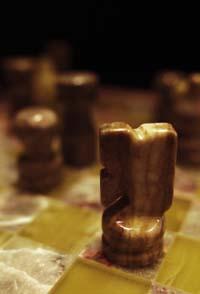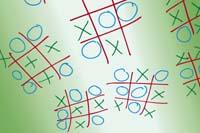Play of the master

In the shepherd's game (three in stripe), almost all matches start the same way: the first player places his tile in the central position. It is the best option. Starting from the central position, the line could be formed in four directions, placing the tile in a corner, in three directions, and placed in the central position on one side, only in two. There is no need to be a mathematician to detect it.
However, the fact of starting with the central position does not ensure that the first player wins the match. And if the other player plays well he won't lose it. (Of course, that good behavior implies, for example, that the second players put the first tile in a corner, etc. ). To understand it, it is also not necessary to be mathematical.
But yes to analyze what is the most appropriate strategy of games. XX. In the first half of the twentieth century, mathematicians developed a theory to seek perfect strategies for the shepherd's game and other similar games. What's more, it was a theory to know if there is a perfect strategy: the theory of games.
Chess Chess Chess
The game of the shepherd is simple and therefore it is a good starting point to begin to develop the theory of games. But the theory was later carried by experts; for example, it can be applied with chess, with complex games.

Chess and the game of the shepherd have many differences, the majority very remarkable. One of them is the number of moves. In the game of the shepherd is limited, with a maximum of nine moves, since by then all positions are full. In chess, however, there is no limit to moves. When there are few pieces left, in theory they can remain "in return", without the game being finished.
However, for this to not happen, several tie rules have been invented in chess. For example, if in forty moves peons are not moved and pieces of higher value are not eaten, the result is a draw. No one wins. Taking into account the tie rules, mathematicians have calculated that there is a limit of moves that exceeds five thousand players. (However, this limit is much higher than the number of moves of any game).
On the other hand, there are some similarities between the shepherd's game and chess. Both are games between two players. In addition, for one to win, the other has to lose, so it makes no sense to establish alliances. And there are no hidden moves, that is, all games do them in sight.
John von Neumann
The Hungarian mathematician John von Neumann studied the games that meet all these characteristics, and in that study he showed that the theorem that initiated the theory of games, or at least, the modern theory of games that we know today. Von Neumann showed that for this type of games there is a perfect strategy. Not only in the game of the shepherd, but also in chess.
What is the perfect strategy to play chess? At the moment no one knows, mathematicians have not yet calculated this strategy. The only thing they have done has been to show that there is a perfect strategy. If they found it, they could schedule a computer that does not lose in chess, for example, but for the moment they cannot. On that way, the matches between the computer Deep blue and Gary Kasparov were very famous; the computer did not have an irresistible system to conquer Kasparov. Sometimes he won the machine, other times Kasparov.

It should be noted that mathematicians do not know anything about this perfect strategy. It exists, but they do not know what would be the result of a game applying the perfect strategy. It is clear that with the application of this strategy you could not lose, but perhaps neither win. In the shepherd game it is clearly seen; if the two players use the perfect strategy no one wins. Tie. Perhaps the same thing happens in chess, and perhaps not. Mathematicians assume that if the perfect strategy is the winner, white pieces would win matches because they have the advantage of the first move. But who knows.
This does not mean that the theory of games leaves chess worthless. Although the perfect strategy is calculated, it would only work in some conditions. In the game of the shepherd is clearly seen. According to the theory of games can not be lost, but there are those who lose it.
This is because not everyone always uses the perfect strategy. The theory of games only serves when the two players play as best as possible. It doesn't work with a player who doesn't mind losing or starting to experiment.
In addition, to apply the theory of games, all players must know all possible moves, remember the previous ones, etc. For a human being it is almost impossible to do it in chess, so there is no fear of finding a perfect strategy. Although they find it, chess will be an interesting game.
Three players
Not all games are between two players. On many occasions, three, four, ten thousand or one million people can participate. Of course, the more players participate, the more complex the mathematical analysis of a game will be.

Among them, the alliances. In the three player games, if an alliance occurs between two, the game becomes a game between two: a player against a partner. The increase of players implies more strategies of alliances. It's not a nonsense, in games with many players there are always alliances.
This can be due to economic issues of real life, in which millions of people defend individual economic interests. But the individual strategies are not used, but the group ones, since the money raised is often a winning strategy and a way to unite a lot of money is to combine the interest and money of many 'players'.
Real Games Real Games
The theory of games was applied immediately in what was not a game, especially in the economic and military. The negotiation between unions and companies is a game between two participants, the fight between two armies.
This does not mean that the theory announces a perfect strategy, but mathematical analysis contributes to the development of a convincing strategy. Neumann himself pointed out clearly, for example, that the theory of games does not serve to make money on the stock market, while in negotiations it may be useful.
At the same time, in the case of war, the theory does not guarantee that it will win an army, but it can help to choose objectives. For example, many believe the game theory helped Americans decide where to launch the atomic bomb during World War II. Logically, Kyoto was a very strategic city, but it was launched at Hiroshima. Why? It could be a matter of strategy, probably the biggest bombing the Japanese expected in Kyoto.

The theory helps to perform the analysis of the game (situation) by means of a mathematical analysis. However, for various reasons it does not give a perfect strategy in the economy, war and many other 'games' of real life.
The first reason is that real games are very complex. They are not as simple in the approaches as the game of the shepherd or chess. As discussed above, alliances and the high number of players are involved. But it's not just that.
The second reason for not giving the perfect strategies is that the theory of games takes into account the ideal players, that is, the players who make the perfect moves. But in reality people are not like that, they make mistakes, use poorly designed strategies, and in many cases they do not take into account everything that needs to be taken into account. Therefore, the theory of games is not a mathematical model of reality.







